Evaluating Roper-Logan-Tierney Model & Clinical Reasoning Cycle
VerifiedAdded on 2023/06/11
|5
|1661
|450
Journal and Reflective Writing
AI Summary
This reflective writing evaluates the Roper-Logan-Tierney (RLT) model of care and the Clinical Reasoning Cycle (CRC), highlighting the influence of sociological, biological, environmental, and psychological factors on an individual's health. The reflection utilizes Gibb's reflective cycle to analyze feelings and experiences during learning sessions focused on factors influencing care quality. The RLT model's emphasis on assessing daily activities to promote patient independence is discussed, along with the importance of considering socio-economic and environmental factors. The reflection also covers the application of logic in individualizing patient care and the limitations of the RLT model. The author reflects on the need for continuous learning and vigilance in nursing, emphasizing the importance of observation, reasoning, and judgment in providing effective and humane patient care, with reference to a case study involving Jimmy.
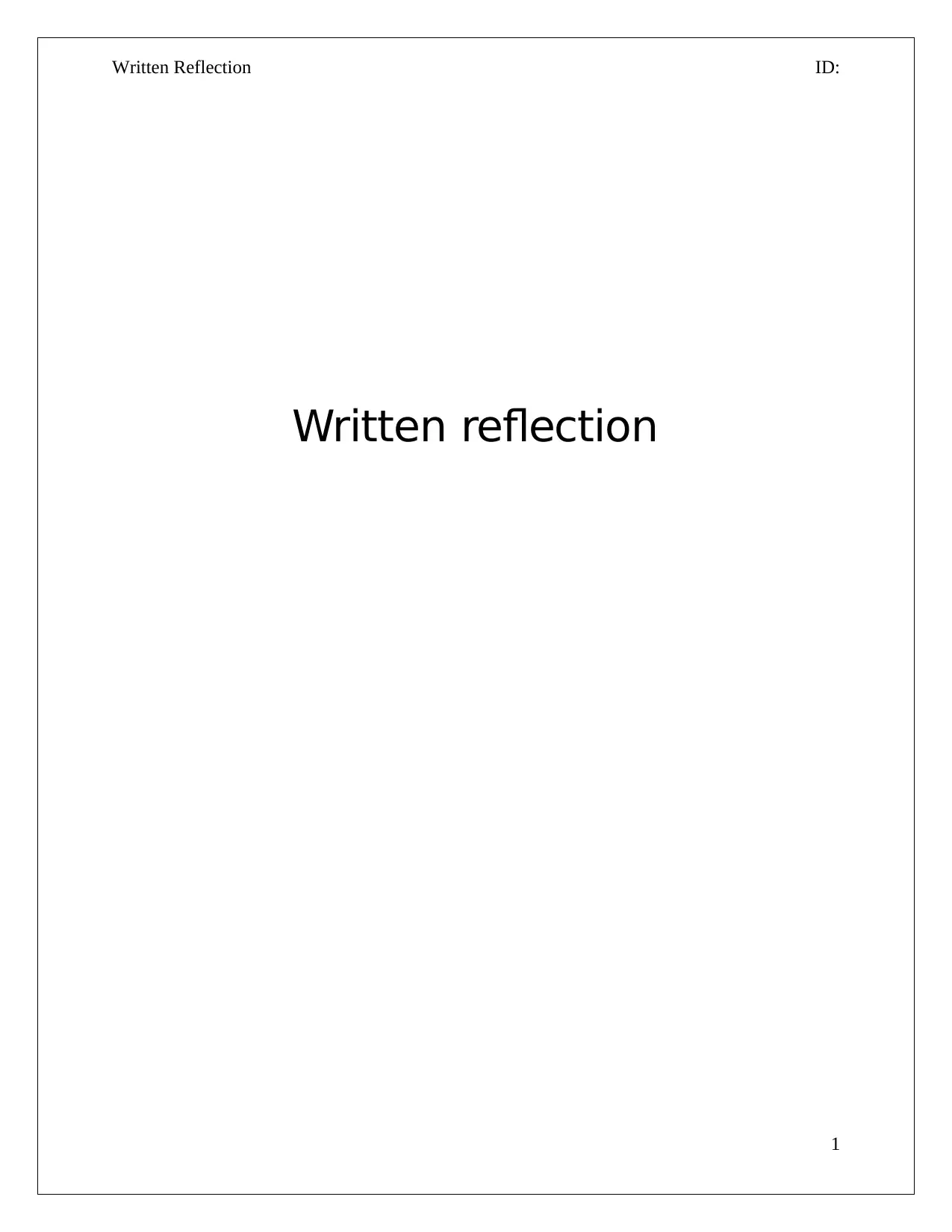
Written Reflection ID:
Written reflection
1
Written reflection
1
Paraphrase This Document
Need a fresh take? Get an instant paraphrase of this document with our AI Paraphraser
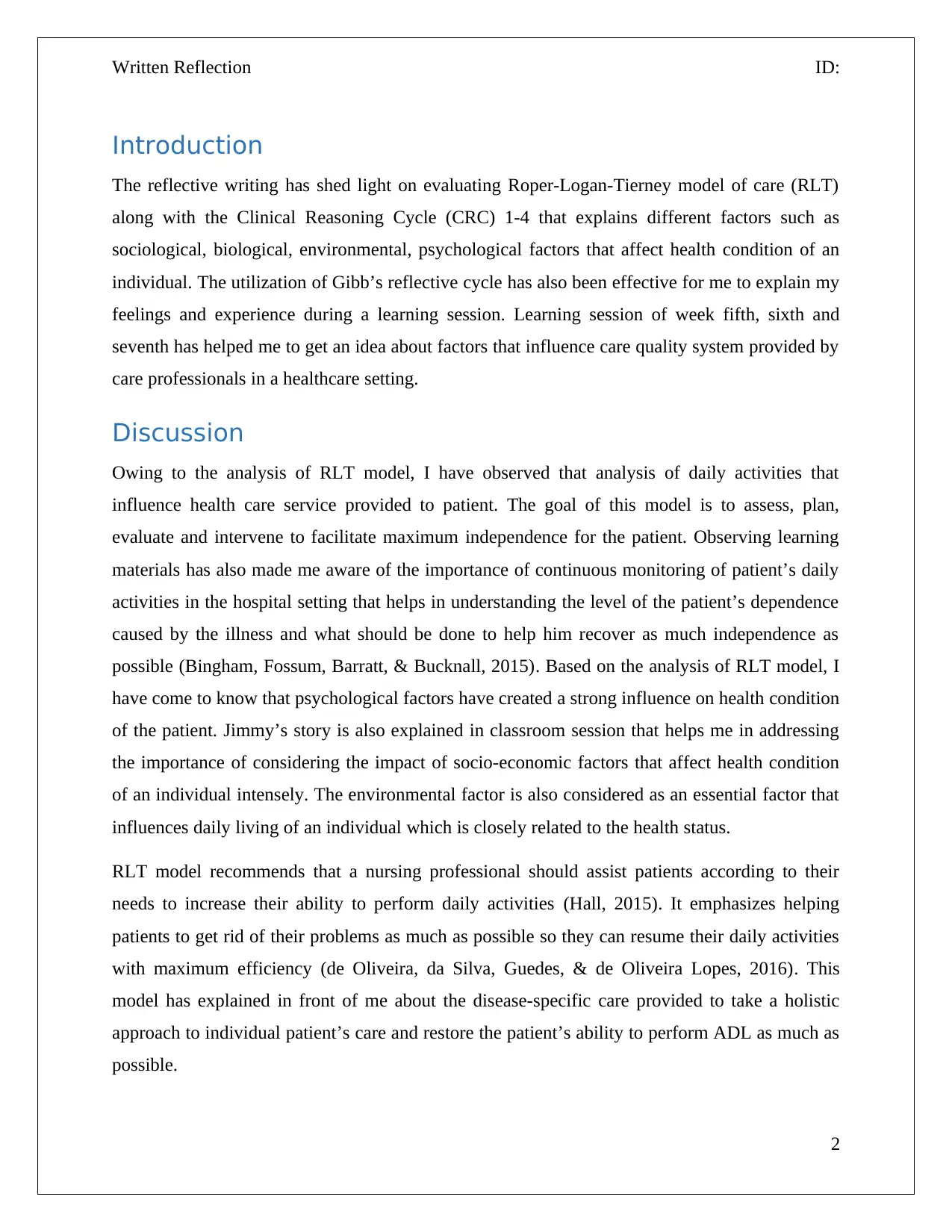
Written Reflection ID:
Introduction
The reflective writing has shed light on evaluating Roper-Logan-Tierney model of care (RLT)
along with the Clinical Reasoning Cycle (CRC) 1-4 that explains different factors such as
sociological, biological, environmental, psychological factors that affect health condition of an
individual. The utilization of Gibb’s reflective cycle has also been effective for me to explain my
feelings and experience during a learning session. Learning session of week fifth, sixth and
seventh has helped me to get an idea about factors that influence care quality system provided by
care professionals in a healthcare setting.
Discussion
Owing to the analysis of RLT model, I have observed that analysis of daily activities that
influence health care service provided to patient. The goal of this model is to assess, plan,
evaluate and intervene to facilitate maximum independence for the patient. Observing learning
materials has also made me aware of the importance of continuous monitoring of patient’s daily
activities in the hospital setting that helps in understanding the level of the patient’s dependence
caused by the illness and what should be done to help him recover as much independence as
possible (Bingham, Fossum, Barratt, & Bucknall, 2015). Based on the analysis of RLT model, I
have come to know that psychological factors have created a strong influence on health condition
of the patient. Jimmy’s story is also explained in classroom session that helps me in addressing
the importance of considering the impact of socio-economic factors that affect health condition
of an individual intensely. The environmental factor is also considered as an essential factor that
influences daily living of an individual which is closely related to the health status.
RLT model recommends that a nursing professional should assist patients according to their
needs to increase their ability to perform daily activities (Hall, 2015). It emphasizes helping
patients to get rid of their problems as much as possible so they can resume their daily activities
with maximum efficiency (de Oliveira, da Silva, Guedes, & de Oliveira Lopes, 2016). This
model has explained in front of me about the disease-specific care provided to take a holistic
approach to individual patient’s care and restore the patient’s ability to perform ADL as much as
possible.
2
Introduction
The reflective writing has shed light on evaluating Roper-Logan-Tierney model of care (RLT)
along with the Clinical Reasoning Cycle (CRC) 1-4 that explains different factors such as
sociological, biological, environmental, psychological factors that affect health condition of an
individual. The utilization of Gibb’s reflective cycle has also been effective for me to explain my
feelings and experience during a learning session. Learning session of week fifth, sixth and
seventh has helped me to get an idea about factors that influence care quality system provided by
care professionals in a healthcare setting.
Discussion
Owing to the analysis of RLT model, I have observed that analysis of daily activities that
influence health care service provided to patient. The goal of this model is to assess, plan,
evaluate and intervene to facilitate maximum independence for the patient. Observing learning
materials has also made me aware of the importance of continuous monitoring of patient’s daily
activities in the hospital setting that helps in understanding the level of the patient’s dependence
caused by the illness and what should be done to help him recover as much independence as
possible (Bingham, Fossum, Barratt, & Bucknall, 2015). Based on the analysis of RLT model, I
have come to know that psychological factors have created a strong influence on health condition
of the patient. Jimmy’s story is also explained in classroom session that helps me in addressing
the importance of considering the impact of socio-economic factors that affect health condition
of an individual intensely. The environmental factor is also considered as an essential factor that
influences daily living of an individual which is closely related to the health status.
RLT model recommends that a nursing professional should assist patients according to their
needs to increase their ability to perform daily activities (Hall, 2015). It emphasizes helping
patients to get rid of their problems as much as possible so they can resume their daily activities
with maximum efficiency (de Oliveira, da Silva, Guedes, & de Oliveira Lopes, 2016). This
model has explained in front of me about the disease-specific care provided to take a holistic
approach to individual patient’s care and restore the patient’s ability to perform ADL as much as
possible.
2
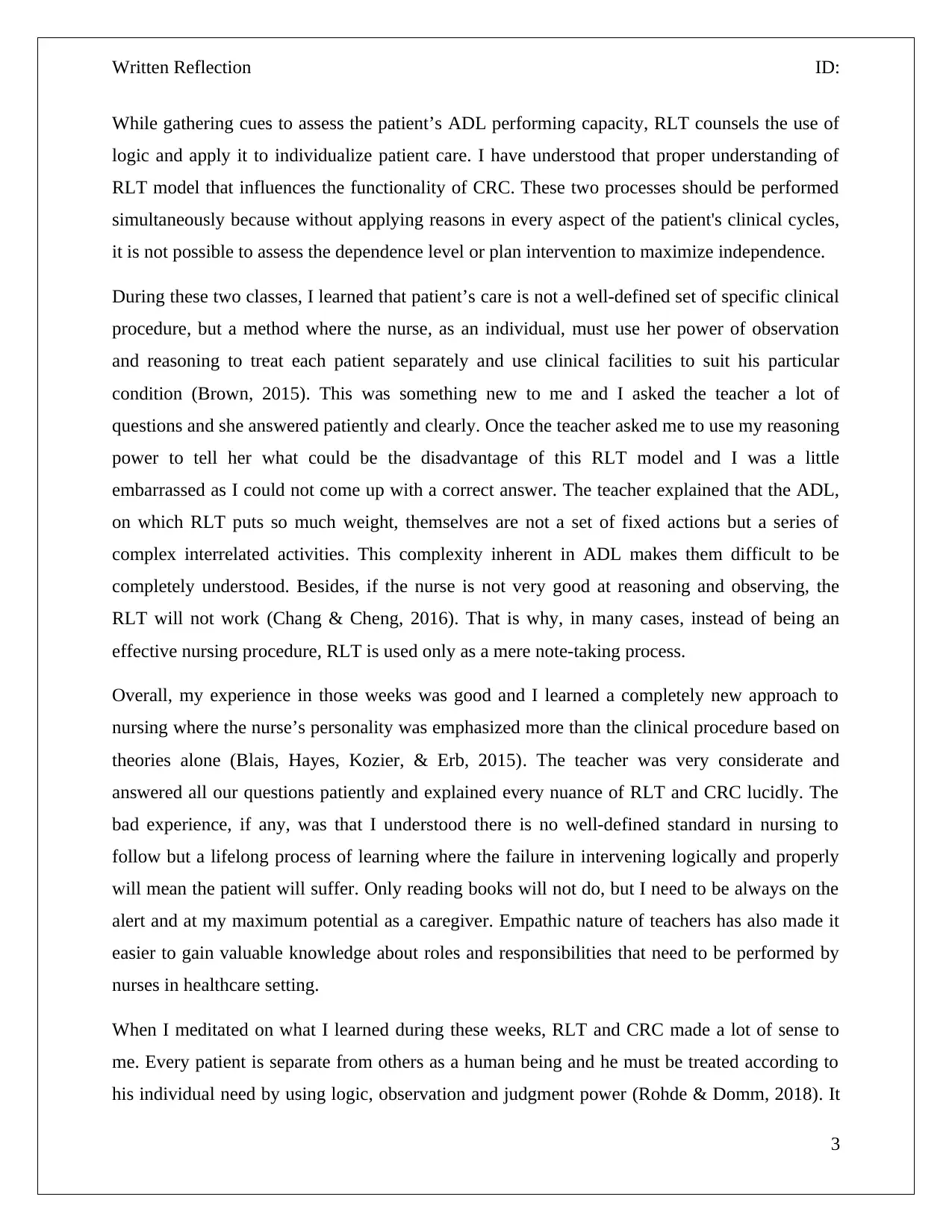
Written Reflection ID:
While gathering cues to assess the patient’s ADL performing capacity, RLT counsels the use of
logic and apply it to individualize patient care. I have understood that proper understanding of
RLT model that influences the functionality of CRC. These two processes should be performed
simultaneously because without applying reasons in every aspect of the patient's clinical cycles,
it is not possible to assess the dependence level or plan intervention to maximize independence.
During these two classes, I learned that patient’s care is not a well-defined set of specific clinical
procedure, but a method where the nurse, as an individual, must use her power of observation
and reasoning to treat each patient separately and use clinical facilities to suit his particular
condition (Brown, 2015). This was something new to me and I asked the teacher a lot of
questions and she answered patiently and clearly. Once the teacher asked me to use my reasoning
power to tell her what could be the disadvantage of this RLT model and I was a little
embarrassed as I could not come up with a correct answer. The teacher explained that the ADL,
on which RLT puts so much weight, themselves are not a set of fixed actions but a series of
complex interrelated activities. This complexity inherent in ADL makes them difficult to be
completely understood. Besides, if the nurse is not very good at reasoning and observing, the
RLT will not work (Chang & Cheng, 2016). That is why, in many cases, instead of being an
effective nursing procedure, RLT is used only as a mere note-taking process.
Overall, my experience in those weeks was good and I learned a completely new approach to
nursing where the nurse’s personality was emphasized more than the clinical procedure based on
theories alone (Blais, Hayes, Kozier, & Erb, 2015). The teacher was very considerate and
answered all our questions patiently and explained every nuance of RLT and CRC lucidly. The
bad experience, if any, was that I understood there is no well-defined standard in nursing to
follow but a lifelong process of learning where the failure in intervening logically and properly
will mean the patient will suffer. Only reading books will not do, but I need to be always on the
alert and at my maximum potential as a caregiver. Empathic nature of teachers has also made it
easier to gain valuable knowledge about roles and responsibilities that need to be performed by
nurses in healthcare setting.
When I meditated on what I learned during these weeks, RLT and CRC made a lot of sense to
me. Every patient is separate from others as a human being and he must be treated according to
his individual need by using logic, observation and judgment power (Rohde & Domm, 2018). It
3
While gathering cues to assess the patient’s ADL performing capacity, RLT counsels the use of
logic and apply it to individualize patient care. I have understood that proper understanding of
RLT model that influences the functionality of CRC. These two processes should be performed
simultaneously because without applying reasons in every aspect of the patient's clinical cycles,
it is not possible to assess the dependence level or plan intervention to maximize independence.
During these two classes, I learned that patient’s care is not a well-defined set of specific clinical
procedure, but a method where the nurse, as an individual, must use her power of observation
and reasoning to treat each patient separately and use clinical facilities to suit his particular
condition (Brown, 2015). This was something new to me and I asked the teacher a lot of
questions and she answered patiently and clearly. Once the teacher asked me to use my reasoning
power to tell her what could be the disadvantage of this RLT model and I was a little
embarrassed as I could not come up with a correct answer. The teacher explained that the ADL,
on which RLT puts so much weight, themselves are not a set of fixed actions but a series of
complex interrelated activities. This complexity inherent in ADL makes them difficult to be
completely understood. Besides, if the nurse is not very good at reasoning and observing, the
RLT will not work (Chang & Cheng, 2016). That is why, in many cases, instead of being an
effective nursing procedure, RLT is used only as a mere note-taking process.
Overall, my experience in those weeks was good and I learned a completely new approach to
nursing where the nurse’s personality was emphasized more than the clinical procedure based on
theories alone (Blais, Hayes, Kozier, & Erb, 2015). The teacher was very considerate and
answered all our questions patiently and explained every nuance of RLT and CRC lucidly. The
bad experience, if any, was that I understood there is no well-defined standard in nursing to
follow but a lifelong process of learning where the failure in intervening logically and properly
will mean the patient will suffer. Only reading books will not do, but I need to be always on the
alert and at my maximum potential as a caregiver. Empathic nature of teachers has also made it
easier to gain valuable knowledge about roles and responsibilities that need to be performed by
nurses in healthcare setting.
When I meditated on what I learned during these weeks, RLT and CRC made a lot of sense to
me. Every patient is separate from others as a human being and he must be treated according to
his individual need by using logic, observation and judgment power (Rohde & Domm, 2018). It
3
⊘ This is a preview!⊘
Do you want full access?
Subscribe today to unlock all pages.

Trusted by 1+ million students worldwide
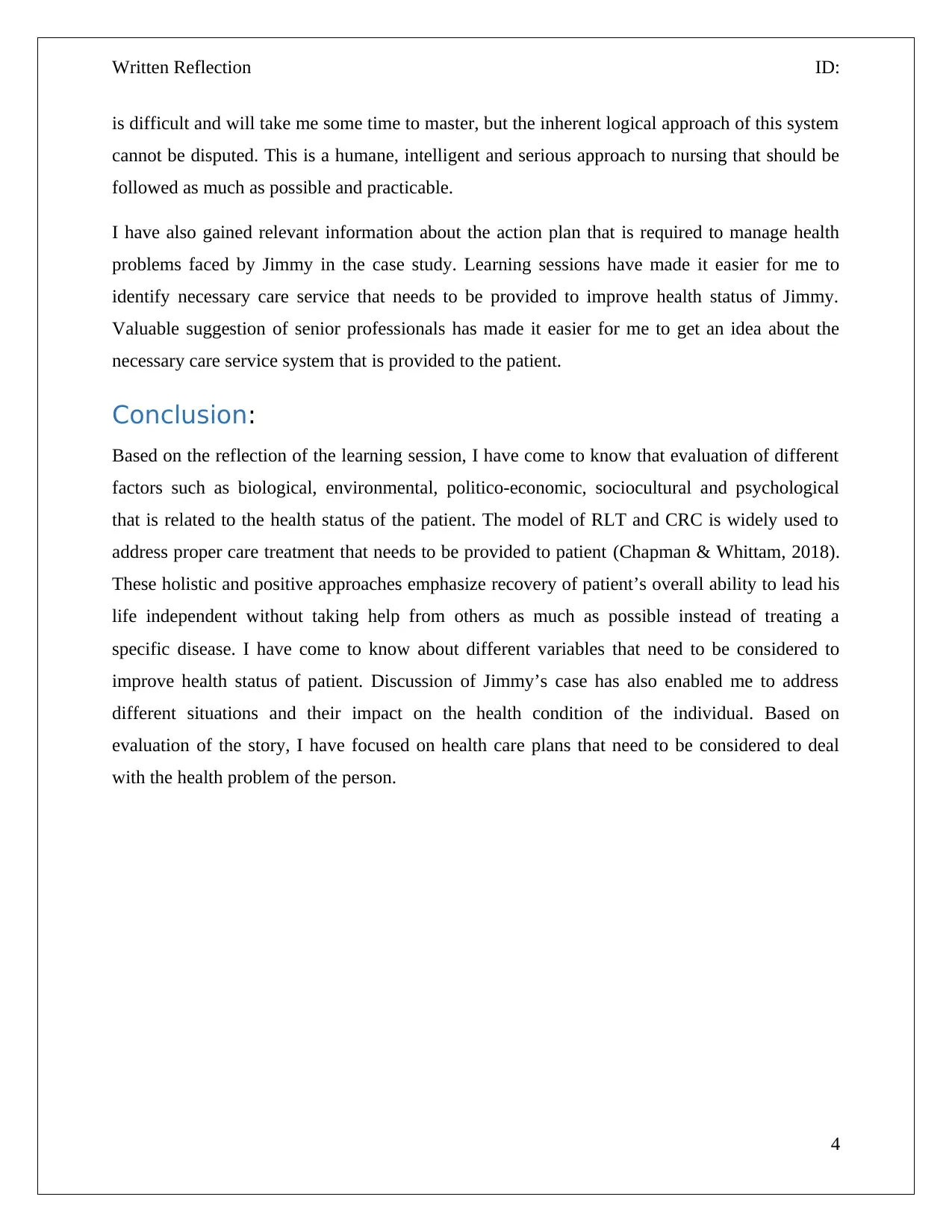
Written Reflection ID:
is difficult and will take me some time to master, but the inherent logical approach of this system
cannot be disputed. This is a humane, intelligent and serious approach to nursing that should be
followed as much as possible and practicable.
I have also gained relevant information about the action plan that is required to manage health
problems faced by Jimmy in the case study. Learning sessions have made it easier for me to
identify necessary care service that needs to be provided to improve health status of Jimmy.
Valuable suggestion of senior professionals has made it easier for me to get an idea about the
necessary care service system that is provided to the patient.
Conclusion:
Based on the reflection of the learning session, I have come to know that evaluation of different
factors such as biological, environmental, politico-economic, sociocultural and psychological
that is related to the health status of the patient. The model of RLT and CRC is widely used to
address proper care treatment that needs to be provided to patient (Chapman & Whittam, 2018).
These holistic and positive approaches emphasize recovery of patient’s overall ability to lead his
life independent without taking help from others as much as possible instead of treating a
specific disease. I have come to know about different variables that need to be considered to
improve health status of patient. Discussion of Jimmy’s case has also enabled me to address
different situations and their impact on the health condition of the individual. Based on
evaluation of the story, I have focused on health care plans that need to be considered to deal
with the health problem of the person.
4
is difficult and will take me some time to master, but the inherent logical approach of this system
cannot be disputed. This is a humane, intelligent and serious approach to nursing that should be
followed as much as possible and practicable.
I have also gained relevant information about the action plan that is required to manage health
problems faced by Jimmy in the case study. Learning sessions have made it easier for me to
identify necessary care service that needs to be provided to improve health status of Jimmy.
Valuable suggestion of senior professionals has made it easier for me to get an idea about the
necessary care service system that is provided to the patient.
Conclusion:
Based on the reflection of the learning session, I have come to know that evaluation of different
factors such as biological, environmental, politico-economic, sociocultural and psychological
that is related to the health status of the patient. The model of RLT and CRC is widely used to
address proper care treatment that needs to be provided to patient (Chapman & Whittam, 2018).
These holistic and positive approaches emphasize recovery of patient’s overall ability to lead his
life independent without taking help from others as much as possible instead of treating a
specific disease. I have come to know about different variables that need to be considered to
improve health status of patient. Discussion of Jimmy’s case has also enabled me to address
different situations and their impact on the health condition of the individual. Based on
evaluation of the story, I have focused on health care plans that need to be considered to deal
with the health problem of the person.
4
Paraphrase This Document
Need a fresh take? Get an instant paraphrase of this document with our AI Paraphraser
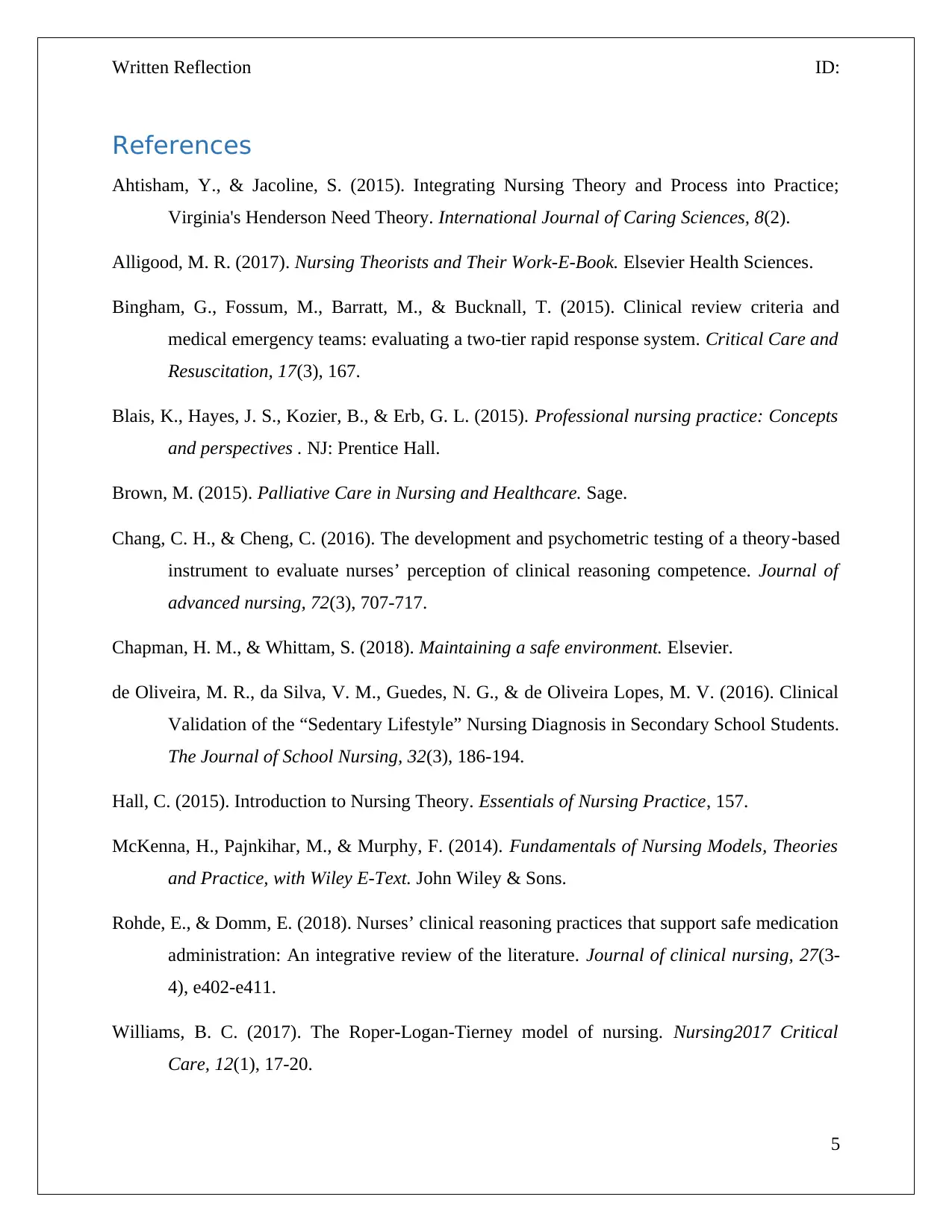
Written Reflection ID:
References
Ahtisham, Y., & Jacoline, S. (2015). Integrating Nursing Theory and Process into Practice;
Virginia's Henderson Need Theory. International Journal of Caring Sciences, 8(2).
Alligood, M. R. (2017). Nursing Theorists and Their Work-E-Book. Elsevier Health Sciences.
Bingham, G., Fossum, M., Barratt, M., & Bucknall, T. (2015). Clinical review criteria and
medical emergency teams: evaluating a two-tier rapid response system. Critical Care and
Resuscitation, 17(3), 167.
Blais, K., Hayes, J. S., Kozier, B., & Erb, G. L. (2015). Professional nursing practice: Concepts
and perspectives . NJ: Prentice Hall.
Brown, M. (2015). Palliative Care in Nursing and Healthcare. Sage.
Chang, C. H., & Cheng, C. (2016). The development and psychometric testing of a theory‐based
instrument to evaluate nurses’ perception of clinical reasoning competence. Journal of
advanced nursing, 72(3), 707-717.
Chapman, H. M., & Whittam, S. (2018). Maintaining a safe environment. Elsevier.
de Oliveira, M. R., da Silva, V. M., Guedes, N. G., & de Oliveira Lopes, M. V. (2016). Clinical
Validation of the “Sedentary Lifestyle” Nursing Diagnosis in Secondary School Students.
The Journal of School Nursing, 32(3), 186-194.
Hall, C. (2015). Introduction to Nursing Theory. Essentials of Nursing Practice, 157.
McKenna, H., Pajnkihar, M., & Murphy, F. (2014). Fundamentals of Nursing Models, Theories
and Practice, with Wiley E-Text. John Wiley & Sons.
Rohde, E., & Domm, E. (2018). Nurses’ clinical reasoning practices that support safe medication
administration: An integrative review of the literature. Journal of clinical nursing, 27(3-
4), e402-e411.
Williams, B. C. (2017). The Roper-Logan-Tierney model of nursing. Nursing2017 Critical
Care, 12(1), 17-20.
5
References
Ahtisham, Y., & Jacoline, S. (2015). Integrating Nursing Theory and Process into Practice;
Virginia's Henderson Need Theory. International Journal of Caring Sciences, 8(2).
Alligood, M. R. (2017). Nursing Theorists and Their Work-E-Book. Elsevier Health Sciences.
Bingham, G., Fossum, M., Barratt, M., & Bucknall, T. (2015). Clinical review criteria and
medical emergency teams: evaluating a two-tier rapid response system. Critical Care and
Resuscitation, 17(3), 167.
Blais, K., Hayes, J. S., Kozier, B., & Erb, G. L. (2015). Professional nursing practice: Concepts
and perspectives . NJ: Prentice Hall.
Brown, M. (2015). Palliative Care in Nursing and Healthcare. Sage.
Chang, C. H., & Cheng, C. (2016). The development and psychometric testing of a theory‐based
instrument to evaluate nurses’ perception of clinical reasoning competence. Journal of
advanced nursing, 72(3), 707-717.
Chapman, H. M., & Whittam, S. (2018). Maintaining a safe environment. Elsevier.
de Oliveira, M. R., da Silva, V. M., Guedes, N. G., & de Oliveira Lopes, M. V. (2016). Clinical
Validation of the “Sedentary Lifestyle” Nursing Diagnosis in Secondary School Students.
The Journal of School Nursing, 32(3), 186-194.
Hall, C. (2015). Introduction to Nursing Theory. Essentials of Nursing Practice, 157.
McKenna, H., Pajnkihar, M., & Murphy, F. (2014). Fundamentals of Nursing Models, Theories
and Practice, with Wiley E-Text. John Wiley & Sons.
Rohde, E., & Domm, E. (2018). Nurses’ clinical reasoning practices that support safe medication
administration: An integrative review of the literature. Journal of clinical nursing, 27(3-
4), e402-e411.
Williams, B. C. (2017). The Roper-Logan-Tierney model of nursing. Nursing2017 Critical
Care, 12(1), 17-20.
5
1 out of 5
Related Documents
Your All-in-One AI-Powered Toolkit for Academic Success.
+13062052269
info@desklib.com
Available 24*7 on WhatsApp / Email
![[object Object]](/_next/static/media/star-bottom.7253800d.svg)
Unlock your academic potential
Copyright © 2020–2025 A2Z Services. All Rights Reserved. Developed and managed by ZUCOL.





